Euripides, Sophocles and Diogenes of Aberdeen Line
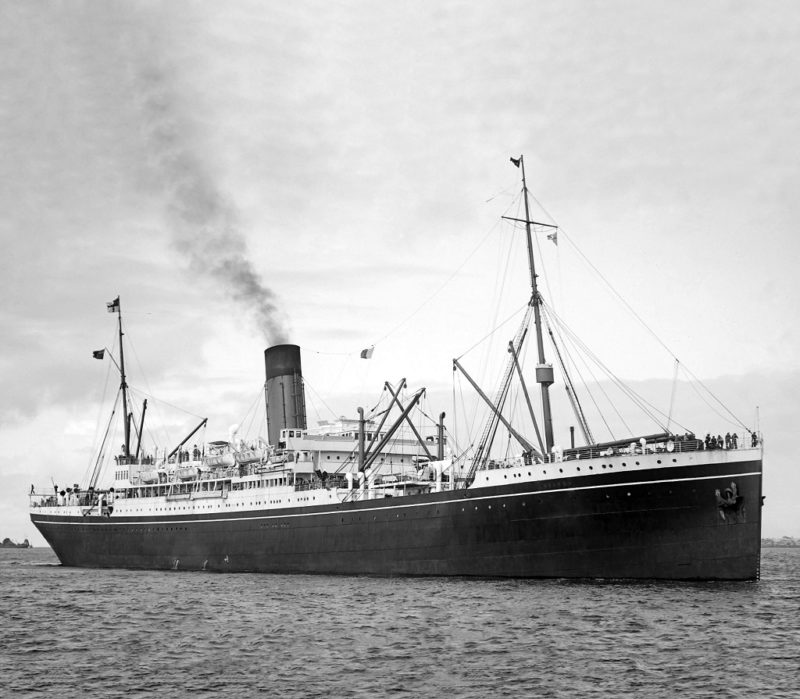
George Thompson was born in Aberdeen on 23rd June 1804, and together with six other merchant families from that city formed the Aberdeen Line at the age of 21 years in 1825. The first sailing ships were very small, with Childe Harold of only 116grt and Amity, Mansfield and Sir William Wallace no bigger than 321 grt. Timber was imported from Canada until the 1840s, and the Aberdeen Line sailing ships then ventured into the Baltic and the Mediterranean, to the United States of America, down to South Africa and South America, and to the Far East and China via the Cape of Good Hope.
The sailing ship Anemone reached Melbourne in 1840 in the first association of a trade with Australia that became the Aberdeen Line main trade. Two years later, the sailing ship Prince of Wales was chartered to carry a group of one hundred migrants to Port Nicholson, to begin the migrant trade to Australia. In 1847, a regular trade by the company began with Australia, with Phoenician of 478grt and built in that year, taking an average of 90 days from London to Sydney. In 1850, the Aberdeen built sailing ship John Bunyan of 526grt made the first company passage from Shanghai to London in 102 days with tea, the start of a trade that became very profitable for Aberdeen Line for the next three decades. Crews of forty British seamen handled the clipper ships Jerusalem, Thyatira and the famous Thermopylae with expert seamanship homewards from China with the first tea of the season on fast passages, making the profits of the Aberdeen Line soar and prosper.
In the 15 year period between 1860 and 1875, Aberdeen Line built two dozen fast clippers, including the legendary Thermopylae, which raced Cutty Sark home with the first tea for nine years and beat her on occasion. The demand for fast transport of the new crop of tea led to competition from fast clipper ships of many countries and many British shipping lines. The Aberdeen Line fast clippers with beautiful clipper bowsprits earned an enviable reputation for their fast sailing qualities, carrying their famous red and blue house flag with a central six pointed white star, and gorgeous light green painted hulls.
Thermopylae was of 991 grt and was built in 1868 at the famous clipper ship building yard of W. Hood & Company of Aberdeen. She was of composite iron frames and wooden planking, and had two decks but no planking was laid on the ‘tween decks. During the racing duels of the nine passages homewards between 1870 and 1878 with Cutty Sark and other very fast clipper ships, Thermopylae recorded better times than her rivals. In support of Thermopylae were the other great sailing clipper ships of Aberdeen Line, including Miltiades, Samuel Plimsoll, the lovely Salamis, Aristides, Smyrna, Pericles and Sophocles, all great names in the annals of the fast clipper ships from China. The final voyage homewards with tea from Foochow of Thermopylae took place in 1881, before being employed exclusively in the wool trade homewards from Australia.
Aberdeen Line steamers proved the superior merits of the triple expansion steam engine in Aberdeen of 3,616 grt in 1881, Australasian of 3,650 grt in 1884, Damascus of 3,609 grt in 1888, Thermopylae (2) of 3,711 grt in 1891, Nineveh of 3,808 grt in 1894, Moravian of 4,573 grt in 1899, Salamis (2) of 4,508 grt in 1899, Sophocles of 4,673 grt purchased in 1900, the twin funnelled Miltiades (2) and Marathon of 6,793 grt in 1903/04, Pericles of 10,925 grt in 1908, and the handsome sisters Themistocles and Demosthenes of 11,231 grt in 1911 from the great shipbuilding yard of Harland & Wolff Ltd. at Belfast. Thermopylae (2) was not as successful as her famous clipper ship predecessor as she was wrecked after only eight years of service on 11th September 1899 off Green Point Light in Table Bay on a foggy night, but all of her crew were saved.

EURIPIDES
Euripides of 14,947 grt was launched on 29th January 1914 at the Belfast yard of Harland & Wolff Ltd., and made a shakedown cruise in June of 1914, a rare innovation at that time. She had dimensions of length overall of 569.7 feet, length between perpendiculars of 550.7 feet, moulded beam of 67.4 feet, moulded depth of 44.1 feet, and she was registered at London and later at Southampton when owned by Shaw, Savill & Albion Co. Ltd. as Akaroa.
She was fifty feet longer and 5.1 feet wider than Themistocles and Demosthenes, on which she was closely modelled. She had three steel decks in her hull plus an awning deck, and a fourth deck in numbers 3 and 4 holds. The fo’c’stle was of length 94 feet, the bridge deck of 215 feet, and the poop deck of length 51 feet. The cellular double bottom extended for 423 feet of her length, and she had a water ballast capacity of 2,482 tonnes in the double bottom tanks, side tanks near the propeller shaft, and fore peak and aft peak.
She had six holds and seven hatches served by a total of nineteen winches and derricks. She had a deadweight of 9,281 tonnes, and a bale cubic capacity of the holds of 440,680 cubic feet, together with 248,000 cubic feet of refrigerated capacity in twelve insulated cargo chambers, with a refrigerated machine of four carbon anhydrous compressors by J. & E. Hall Ltd. of Deptford with granulated cork and brine insulation.
She had accommodation for 140 First Class passengers, 334 in Second Class, and between 750 and one thousand steerage (Third Class) passengers in dormitories in the holds, depending on how the double steel bunks were arranged.
The navigating bridge was well equipped with electric signalling devices and gyro – compasses, and her coal bunkers took the big quantity of 2,700 tonnes to feed five double ended boilers to produce steam at 215 pounds per square inch and pass it to twin triple expansion steam engines and a low pressure steam turbine to the centre shaft of three shafts.
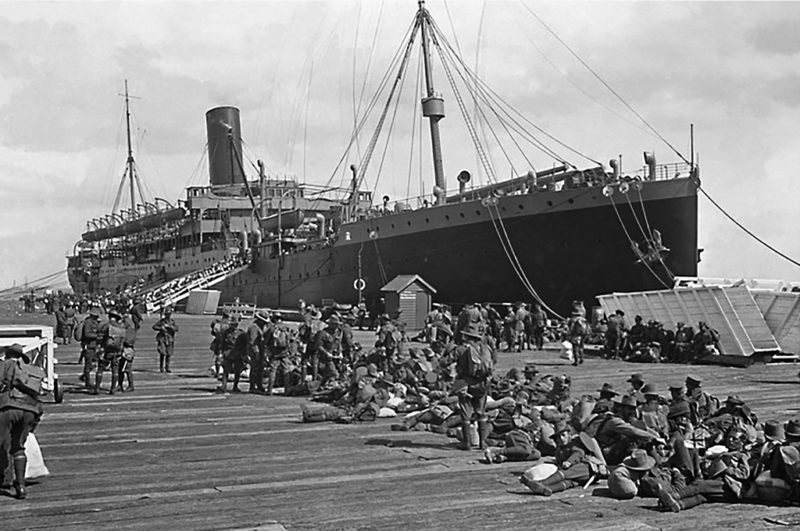
The service speed was 15.0 knots with a higher trials speed on the measured mile off the Isle of Arran and in the North Channel between Northern Ireland and Scotland on 14th June 1914 of 16.5 knots. She was later converted to oil burning in 1932 using fuel oil with a flash point above 150 degrees Fahrenheit.
She had a beautiful light green hull with red boot topping, yellow funnel, white superstructure and buff coloured masts and derricks. She was the largest vessel in the Aberdeen Line fleet, and from 1932 the largest ship in the inter-war Shaw, Savill & Albion Co. Ltd. fleet as Akaroa.
Euripides made her maiden voyage on 1st July 1914 from London to Brisbane calling at Plymouth, Cape Town (20th July), Fremantle (2nd August), Albany (4th August), Adelaide (9th August), Melbourne (13th August), Sydney (NSW) on 15th August and finally Brisbane on 24th August, the final port of call. Dalgety & Company were the Aberdeen Line agents in all of the Australian ports, and J. T. Rennie & Sons and William Anderson & Company in South African ports.
A regular Aberdeen Line fortnightly service from London to Australian ports via the Suez Canal was operated in 1914, together with a regular monthly service to South African and Australian ports, using five ships Euripides, Demosthenes, Themistocles, Marathon and Miltiades.
Remarkably, all five ships survived the torpedoed and bombs of the war, as they were voyaging far from the European theatre of war operated by the shor-range U-boats. The loading berths were in the Royal Docks in London, with the London office of George Thompson & Co. Ltd. at 7 Billiter Square in London EC3.
George Thompson had died in 1895 and management was now in the hands of Harold Sanderson of the Ocean Steamship Company (White Star Line). White Star Line had taken a 50% shareholding in Aberdeen Line and Shaw, Savill & Albion Co. Ltd. (SSA) having also taken a considerable smaller holding.
Euripides was taken over by the Australian Government on requisition at Brisbane on 26th August 1914 for Australian trooping and became the Commodore Convoy ship of the first Australian troop convoy of World War I.
She was given accommodation for 136 officers, 2,204 troops and stables for twenty horses, and under the pennant number A14 and with a grey hull, she embarked the Second Light Horse Regiment at Brisbane, and the 3rd and 4th Infantry Battalions, 1st Field Ambulance Division and six nurses at Sydney (NSW).
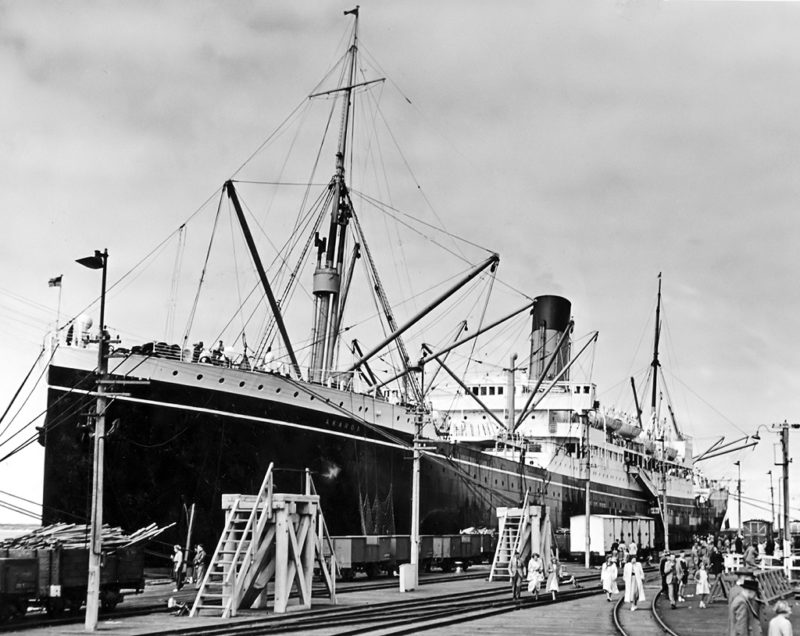
She sailed from the latter port on 20th October 1914 and King George Sound at Albany on 1st November 1914 for Alexandria and the Dardanelles for her ‘Anzac’ troops to take part in the ill-fated Dardanelles campaign. She made seven trooping voyages to this area with the last sailing from Sydney (NSW) on 31st October 1917. A total of 44 infantry battalions, three horse regiments, artillery and mortar guns, as well as medical officers and orderlies were carried on the seven voyages.
Troop training and gun drills were carried out during all of the voyages to bring the troops up to full battle standard. She reverted to British Government control in 1915 and continued to voyage commercially to Australia, for the remainder of the war, the Third Class accommodation in the holds being used by troops.
In February 1919, Euripides commenced to repatriate Australian troops, with a dazzle painted hull, and during this period in 1919 and the whole of her World War I service, she had steamed a magnificent total of 208,307 miles and carried 38,439 troops, the equivalent of four full Army Divisions. The five Aberdeen Line ships had an even greater total of troops carried during the war at 129,500 with total steaming miles of 948,000. Euripides was then overhauled at Belfast and rejoined the Aberdeen Line commercial passenger and cargo service to Australia in November 1920.
She made the last company inbound passenger call at Plymouth in March 1923, and then she and her consorts used Southampton for passenger calls and London for cargo handling.
While Euripides was steaming to Australia under the command of Capt. P. J. Collins OBE, a Variety Show was held onboard by her Catering Department on Friday 13th March 1925 for the passengers, with all proceeds going to Merchant Marine charities. The show had no less than fourteen solo appearances and comedy sketches.
Euripides was laid up at the Gareloch on the Clyde in 1927 for five months, and then began to run on the Liverpool to Australia joint service of Aberdeen Line, White Star Line and Blue Funnel Line.
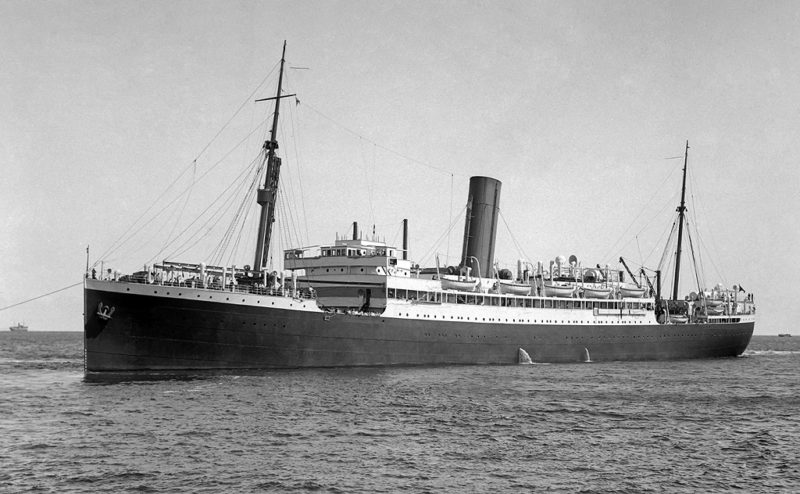
SOPHOCLES and DIOGENES
This pair of twin screw Aberdeen Line passenger and cargo ships was completed by the Belfast yard of Harland & Wolff Ltd. in 1922, Sophocles in February and Diogenes in July of 1922.
They had been launched on 22nd September 1921 and 2nd March 1922 respectively. They had dimensions of overall length of 500.4 feet, moulded depth of 63.2 feet, and moulded depth of 39.6 feet.
They had six holds served by lattice work derricks to the twin masts and twin sets of posts. They had cruiser sterns with three decks in their hulls, the upper deck being the Shelter Deck.
They used four double ended boilers and one single ended boiler to raise steam at 215 pounds per square inch to pass to four Brown-Curtis Harland & Wolff double reduction steam turbines to produce 5,200 shp and a service speed of 14 knots.
The hulls were subdivided by nine bulkheads, and their cellular double bottom of length 425 feet carried a total of 2,195 tonnes of water ballast, together with some water ballast in the tunnels near the propeller shafts and in the fore peak and aft peak.
They had cruiser sterns with a hold capacity for 279,178 cubic feet of cargo. They were converted to oil burning in 1926 using fuel oil with a flash point above 150 degrees Fahrenheit, each conversion costing £90,000.

Sophocles made her maiden voyage to Australia via the Suez Canal on 1st March 1922, followed by Diogenes on 4th July 1922.
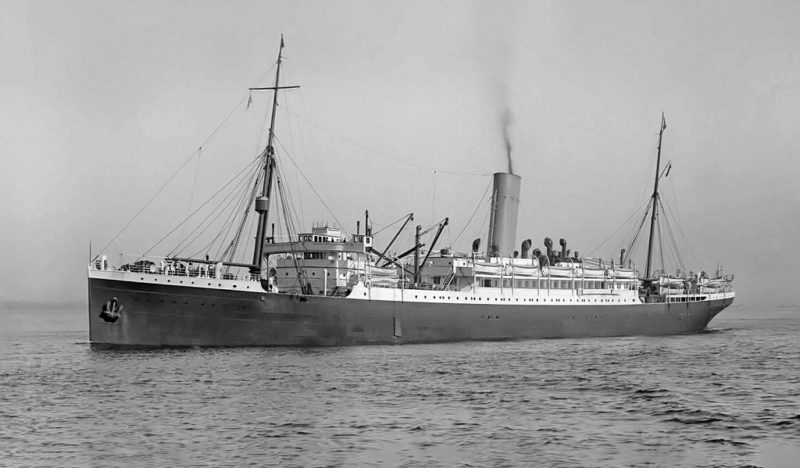
They replaced Marathon and Miltiades in the fleet, the older pair had faced much higher operating costs after the war. Euripides, Sophocles, Diogenes, Themistocles and Demosthenes carried on the Aberdeen Line sailings to Australia and South Africa from London and Plymouth.
In 1927, Lord Kylsant, Chairman of Royal Mail Line, acquired control of the Ocean Steam Navigation Company (White Star Line), and also a considerable holding in Shaw, Savill & Albion Co. Ltd. (SSA). He thus gained control of Aberdeen Line as White Star Line owned 50% and SSA had increased their holding in Aberdeen Line to almost a similar holding. SSA forged even stronger links with Aberdeen Line in 1926 by chartering Sophocles and Diogenes to become Tamaroa and Mataroa, in exchange for Waimana and Zealandic to become Herminius and Mamilius in the Aberdeen Line fleet.
Harold Sanderson retired as Chairman of George Thompson & Co. Ltd. on the grounds of ill health in 1928, and was replaced by Lord Kylsant himself, who by this time had purchased the assets of the Australian Commonwealth Line from the Australian Government for £1.9 million.
The five ‘Bay’ Class liners of Moreton Bay, Largs Bay, Hobson’s Bay, Esperance Bay and Jervis Bay plus Ferndale and Fordsdale formed the new Aberdeen & Commonwealth Line operating a new service under the old Aberdeen Line colours and houseflag from London to Australia via the Suez Canal and Colombo.
Lord Kylsant was convicted of issuing a grossly inaccurate and wildly over optimistic share prospectus in 1928 and overreached himself financially before he was given a jail sentence of one year in 1930.
The whole of the Royal Mail Line share structure collapsed around him, dragging around thirty major British liner companies into ruin. They were only very slowly raised over several years from 1933/34 from almost oblivion into much leaner and smaller companies, with very careful control needed over cash flow in the severely depressed freight rates of the 1930s.
SSA purchased from the Official Receiver of Royal Mail Line the debentures of George Thompson & Co. Ltd., as well as the fleet and other assets of Aberdeen Line. Thus, SSA took over Euripides and renamed her Akaroa, and gained full title to Mataroa and Tamaroa. The 11,231grt Themistocles was taken over, sister the 11,223 grt Demosthenes was sent to Blyth for breaking up by Hughes Bolckow, arriving on 18th October 1931. They also took over the 8,010grt Horatius of 1919, which had been transferred to Aberdeen Line in 1925. SSA also secured the return of their 10,898 grt Mamari and the 10,389grt Waimana, which had been operated by Aberdeen Line on charter since 1926.
In April 1933, the Aberdeen & Commonwealth Line Ltd. was set up by Lord Essendon of Furness, Withy & Co. Ltd. together with P. & O., and purchased at the very low price of £0.5 million the five ‘Bay’ class liners to put them back into service. SSA was now part of Furness, Withy & Co. Ltd., and became sole operators of the new Aberdeen & Commonwealth Line in partnership with P. & O.
The five ‘Bay’ Class liners and the vast majority of the Aberdeen Line had thus been rescued from the hands of the Official Receiver after the catastrophic downfall of Royal Mail Line and Lord Kylsant. The Shaw, Savill & Albion Co. Ltd. fleet later in 1933 consisted of 18 ships in Akaroa, Mataroa, Tamaroa, Coptic, Herminius, Karamea, Kia Ora, Mahana, Mahia, Maimoa, Matakana, Otira, Pakeha, Raranga, Tainui, Tairoa, Taranaki, Themistocles and Zealandic. They all had black hulls with a thin white line just below the weather deck, and buff funnels with a black top.
The SSA houseflag was white with a red St. George Cross, and in the left upper white quarter was a blue and red flag with four white stars.
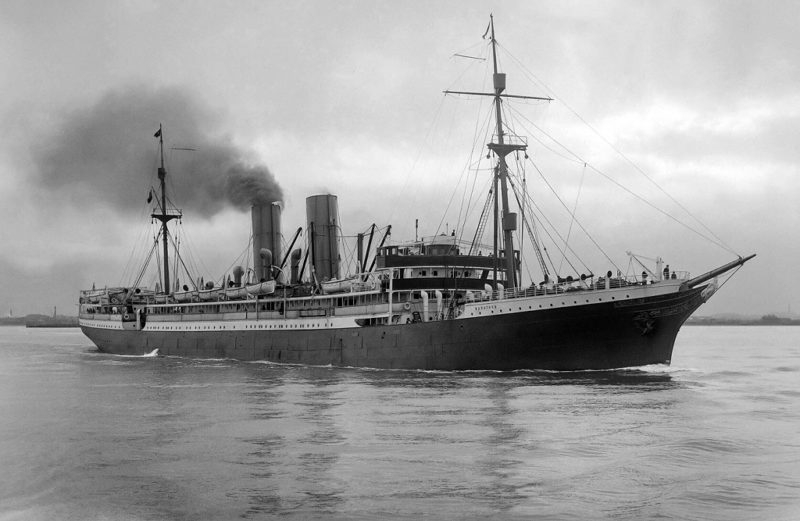
AKAROA, MATAROA and TAMAROA
Euripides made her last voyage to Australia for Aberdeen Line in February and March 1932, and passed under the now completed Sydney Harbour Bridge, which had taken eight years to build with an official opening on 19th March 1932. On her return to the U.K., she was sent to the Hawthorn, Leslie yard at Hebburn on Tyne for a refit costing £100,000, during which she was converted to oil fuel burning with oil tanks holding 4,400 tonnes of bunkers, the First Class accommodation was increased to 200 passengers, and a new swimming pool and gymnasium were fitted. The Third Class accommodation was converted to extra cargo carrying space. She was renamed Akaroa and registered at Southampton for her new Shaw, Savill & Albion Co. Ltd. service to New Zealand ports via the Panama Canal. She sailed in company with Mataroa (the former Diogenes) and Tamaroa (the former Sophocles) to Auckland, Wellington, Lyttelton (Christchurch) and Port Chalmers (Dunedin) with calls at Curacao for bunkers, and occasionally at Pitcairn Island with supplies and mail.
Akaroa made her first voyage to New Zealand ports from Southampton on 28th February 1933 taking just over forty days for the passage, with a record passage of just 33 days to Auckland in November 1933, and other fast passages of 37 days. She was equipped with an echo sounder in 1934, and Mataroa and Tamaroa were converted to one class ships with accommodation for 131 Cabin Class passengers.
At the start of World War II, Akaroa sailed from Southampton on 1st September 1939 for New Zealand, and reached Auckland on 8th October, where Capt. William Horatio Hartman was congratulated by passengers and presented with a silver salver in gratitude for a ‘notable and perilous passage’. On her return voyage, Akaroa called at Curacao on 30th November 1939 and diverted to Halifax (NS) to join convoy HXF12 for arrival at London instead of Southampton on 27th December 1939. She remained in commercial service for the Ministry of War Transport (MOWT) throughout the war, and voyaged both unescorted and in many outward ‘ON’, ‘OS’, and homeward ‘HX’ convoys across the Atlantic and in convoy down the Eastern Seaboard of the U.S.A. to reach Bermuda and then Curacao for bunkers, with occasional calls at Port of Spain (Trinidad) and Kingston (Jamaica). She survived convoy HX228 from New York and Halifax (NS) on 28th February 1943, which was ordered back to Halifax (NS) by the Admiralty after four ships and a destroyer escort had been lost. A wolf pack of nine U-boats lay across the path of the convoy, and it was safer to return to port.

Akaroa and the other survivors of HX228 then formed up in Bedford Basin at Halifax (NS) in convoy HX228A, with Akaroa and the other survivors reaching the familiar outline of Holyhead on Anglesey and then into the shipping channel of the Mersey on 26th March 1943. Capt. William Horatio Hartman, her long time Master, was decorated with the OBE for his superb seamanship and devotion to duty. Akaroa made one long voyage to Montevideo and Buenos Aires during the war, sailing from Liverpool on 17th September 1943 in convoy for Freetown, and then sailed unescorted to the River Plate. After loading a full and vitally needed cargo of meat and grain, she returned unescorted to Freetown, and joined a homeward convoy SL141 to reach Avonmouth on 15th December 1943. She arrived not just at Southampton, London and Liverpool at the end of her long voyages, but also at Milford Haven, Glasgow, Cardiff, Swansea and West Coast and Irish Sea ports during the war.
Mataroa and Tamaroa with their large food carrying capacities also remained in commercial service for the MOWT during the first part of the war. Mataroa in 1940 carried the Post Office censorship unit to Bermuda, and was then converted into a troopship in November 1940, carrying 1,916 troops and officers, with officers in her cabins and troops in dormitories in her holds. Tamaroa was also converted into a troopship at the same time, with accommodation for 1,763 officers and troops. She was Convoy Commodore ship in her first outward convoy that was attacked by the German cruiser Admiral Hipper, which had broken out through the Denmark Strait on 6th and 7th December 1940 into the North Atlantic. However, when the British heavy cruiser Berwick arrived on the scene, Admiral Hipper made off a high speed as the policy of the Kriegsmarine was not to take part in offensive battles and to avoid confrontation. In this way, their big gunned ships and merchant raiders could tie down so many Allied warships, their best chance of producing a starvation surrender by the U.K.
Mataroa and Tamaroa served mostly in troop convoys to South Africa and the River Plate for valuable homeward meat cargoes. Tamaroa also took part in the Operation Torch invasions of North Africa in October 1942, and was the first troopship into Bone. Mataroa in the last months of 1943 and the first half of 1944 was used during the Transatlantic build up of American troops into Northern Ireland and Southern England. American coloured G.I.s were sent to Belfast, as Irish pressure in the Irish Republic and in the U.S.A. decreed that no Americans of Irish descent should be included in case of cross border friction. The U.S. Army stood for no such nonsense from the Irish, and this was the reason that coloured G.I.s were sent to Belfast.
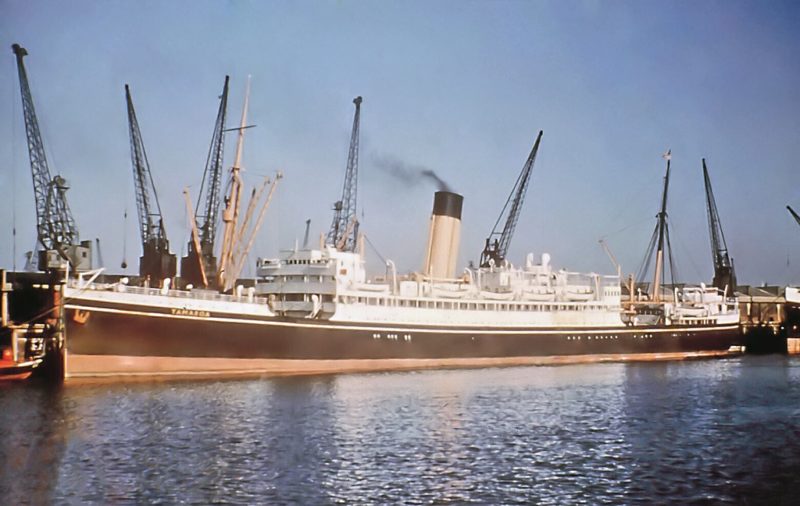
Akaroa, Mataroa and Tamaroa were sent for much needed refits at the end of the war, with Akaroa reconditioned on the Tyne and her passenger accommodation altered to 190 in Cabin Class, not First Class, as some cabins were converted to single berth and others were converted with private bathrooms and facilities. Akaroa re-entered commercial service during early 1946, and Mataroa and Tamaroa re-entered commercial service in April and August 1948 carrying 372 passengers in Tourist Class accommodation, not First Class. Akaroa made her final outward voyage from Southampton to New Zealand ports in early 1954, arriving at Wellington for the last time in February 1954. On her return she was sold in May 1954 for breaking up at Antwerp after forty years of accident-free service during which this fine passenger ship had steamed over two million miles. Tamaroa made her final voyage to New Zealand ports on 24th October 1956, and on her return was sold to Bisco for breaking up at Blyth, where she arrived on 5th March 1957 for demolition by Hughes Bolchow on ‘Battleship Wharf’. Mataroa made her last sailing to New Zealand ports on 21st November 1956, and on her return was sold to Bisco for breaking up, arriving at Faslane on 29th March 1957.
The Aberdeen & Commonwealth Line Ltd. had become an enterprise entirely separate in identity from George Thompson’s Aberdeen Line, although they retained the green hull and houseflag of Aberdeen Line.
The five pre-war ‘Bay’ class passenger liners had been reduced to four with the loss of Jervis Bay while bravely defending the HX84 convoy on 5th November 1940. She was Convoy Commodore ship commanded by Capt. E. S. Fogarty Fegen of the Royal Navy. She had been fitted with eight six inch guns as an Armed Merchant Cruiser, but these were no match when she came up against the heavy cruiser Admiral Scheer, armed with six eleven inch and many smaller guns. The convoy scattered under a smoke screen, and Jervis Bay altered course to steam directly into the fire of the approaching Admiral Scheer. The fading light of evening then allowed many ships of the convoy to evade capture and escape.
hells damaged Jervis Bay before her own guns could be brought into range. She came to a complete stop after fifteen minutes of heavy punishment and she began to sink at 2000 hours with heavy loss of life including her brave Commander, who was awarded a posthumous Victoria Cross.
Esperance Bay had been transferred to SSA in 1936 and renamed Arawa, and she and the remaining liners of the original quintet re-entered commercial service in 1946 on the long routes to New Zealand via either the Panama Canal or the Suez Canal. Arawa arrived for breaking up at Newport in May 1955, Hobson’s Bay was renamed Esperance Bay in 1936 and arrived at Faslane for breaking up on 6th July 1955, and Largs Bay arrived at Barrow in Furness on 11th January 1957, and Moreton Bay arrived for breaking up at Barrow in Furness on 13th April 1957.
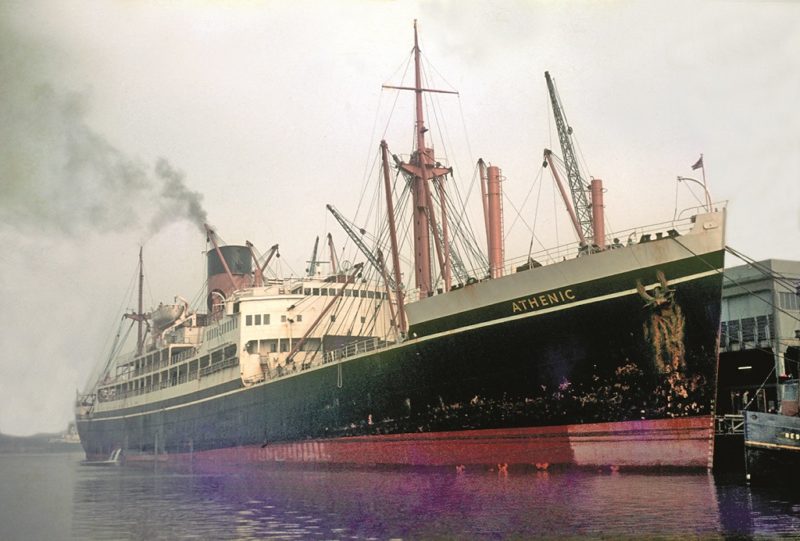
SHAW, SAVILL & ALBION CO. LTD. IN POST-WAR YEARS
Shaw, Savill & Albion Co. Ltd. was founded on 1st January 1883 by the merger of Savill and Company of London (founded in 1808), Albion Line of Glasgow (founded in 1856), and John Leslie & Partners of Aberdeen. When the fleet had been rebuilt during the post-war years, the company celebrated its 75th Anniversary in 1958 with a fleet of 26 ships, including the big passenger liners Dominion Monarch, built in 1939 on Tyneside by Swan, Hunter & Wigham Richardson Ltd., and Southern Cross, built in 1955 by Harland & Wolff Ltd. at Belfast, and two dozen cargo-liners. These were Afric, Alaric, Arabic, Aramaic, Athenic, Canopic, Carnatic, Cedric, Caramic, Coptic, Corinthic, Cretic, Cymric, Delphic, Doric, Gothic, Karamea, Persic, Runic, Suevic, Taranaki, Waipawa, Wairangi and Waiwera.
Dominion Monarch of 27,115 grt had been launched on the Tyne on 27th July 1938 and was completed on 12th January 1939 with accommodation for 525 First Class passengers and with grain cargo carrying capacity of a big 690,000 cubic feet, giving a deadweight of 16,860 tons. She was a quadruple screw motor ship powered by four five cylinder Doxford two stroke single acting diesel engines giving 32,000 bhp and a top speed of 21.6 knots and a service speed of 19.2 knots at 123 rpm. These were the biggest and most powerful Doxford diesel engines built to that date. She began her maiden voyage from London on 17th February 1939 calling at Las Palmas, Cape Town, Fremantle, Melbourne, Sydney (NSW) and Wellington, returning by the same ports. During the period from 1955 to the end of her service in 1961, she always returned homewards via the Pacific, calling at Suva, Papeete, the Panama Canal, Curacao for bunkers and London.
Dominion Monarch was converted to carry 4,050 troops during the war, and by the end of the war she had carried well over 90,000 troops and had steamed over 350,000 miles. She had a scare while in dry-dock at Singapore in early 1942 while her engines were stripped down for maintenance. The Japanese armies were advancing quickly down the Malayan peninsula, and the situation in Singapore deteriorated quickly. As her engines were partially dismantled, she seemed doomed, but her engineers did a magnificent job in the face of the greatest difficulties, and she sailed on 8th February 1942, just two days before the Japanese entered Singapore by the land route across a narrow strip of water to the north of the island.
The four sisters of the ‘Gothic’ class of passenger and cargo-liners supplemented the passenger sailings of Dominion Monarch and Southern Cross to Australia and New Zealand. Athenic, Corinthic, Ceramic and Gothic were completed at Belfast, Birkenhead and Wallsend during 1947/48. They had accommodation for just over 90 passengers with a deadweight of 11,600 tons.
Southern Cross was launched on 17th August 1954 by H. M. The Queen and completed in February 1955 for her Round the World services to Australia and New Zealand. She sailed from Southampton on the westerly circuits via Trinidad, Curacao for bunkers, Panama Canal, Tahiti, Fiji, Wellington, Auckland, Sydney (NSW), Melbourne, Fremantle, Durban, Cape Town, Las Palmas for bunkers and home to Southampton. She also sailed easterly on Round the World circuits, but after the introduction into service of the Tyne built liner Northern Star in 1962, her new partner replaced her on easterly circuits and she made Round the World westerly passages. She had accommodation for 1,160 passengers in one class Tourist Class until she was taken out of service at the end of 1971 after six months of cruising from Liverpool and Southampton to Mediterranean ports. She was sold and continued on a long cruise ship career under the names of Calypso, Calypso I, Azure Seas, and Ocean Breeze until she arrived for breaking up at Chittagong in 2003.
SSA had been controlled by Furness, Withy & Co. Ltd. since 1933, and by 1985 it had become an integral part of Furness Withy Shipping, but owned by C. Y. Tung of Hong Kong after a takeover on 13th February 1980.
In June 1984, the partnership between SSA and Bank Line ended, and the container ship Dunedin was switched to a service from Australia and New Zealand to the Pacific West coast of U.S.A. carrying Californian citrus fruit produce to the Antipodes on charter to the New Zealand Shipping Corporation. She was sold to Hamburg Sud in 1986 and renamed Monte Pascoal, later renamed as Columbus Olivos, Alianca Hamburgo, and MSC Jessica, and was broken up at Alang in India after she was beached there on 6th June 2009.
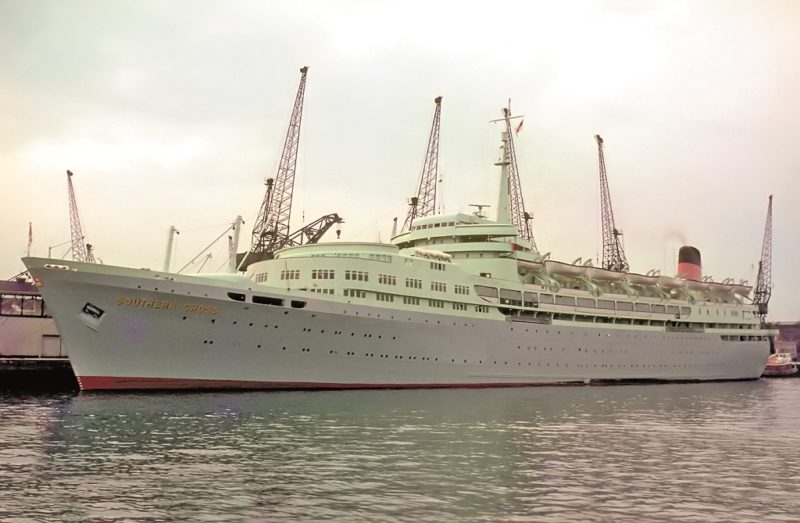

SUMMARY
The period of British maritime history that Aberdeen Line and Shaw, Savill & Albion Co. Ltd. (SSA) covered as shipowners extended from 1825 to 1986, a magnificent 161 years. The graceful liner Euripdes was in service from 1914 to 1932 for Aberdeen Line, and then as Akaroa for SSA from 1932 until she was broken up in 1954, a good career of forty years. Sophocles and Diogenes were in service for Aberdeen Line from 1922 to 1926, and then as Tamaroa and Mataroa for SSA until they were broken up in 1957, after very long careers of 35 years. This trio of graceful and good looking passenger and cargo-liners were part of what made the Red Duster fleet the pride of the U.K., and are sorely missed in the world fleets of today that are owned by just about all of the countries in the world except the U.K., a great loss to British seafarers and the British shipping industry.
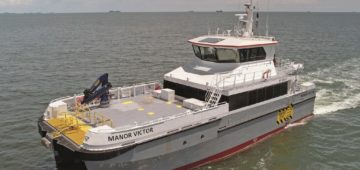



Comments
Sorry, comments are closed for this item